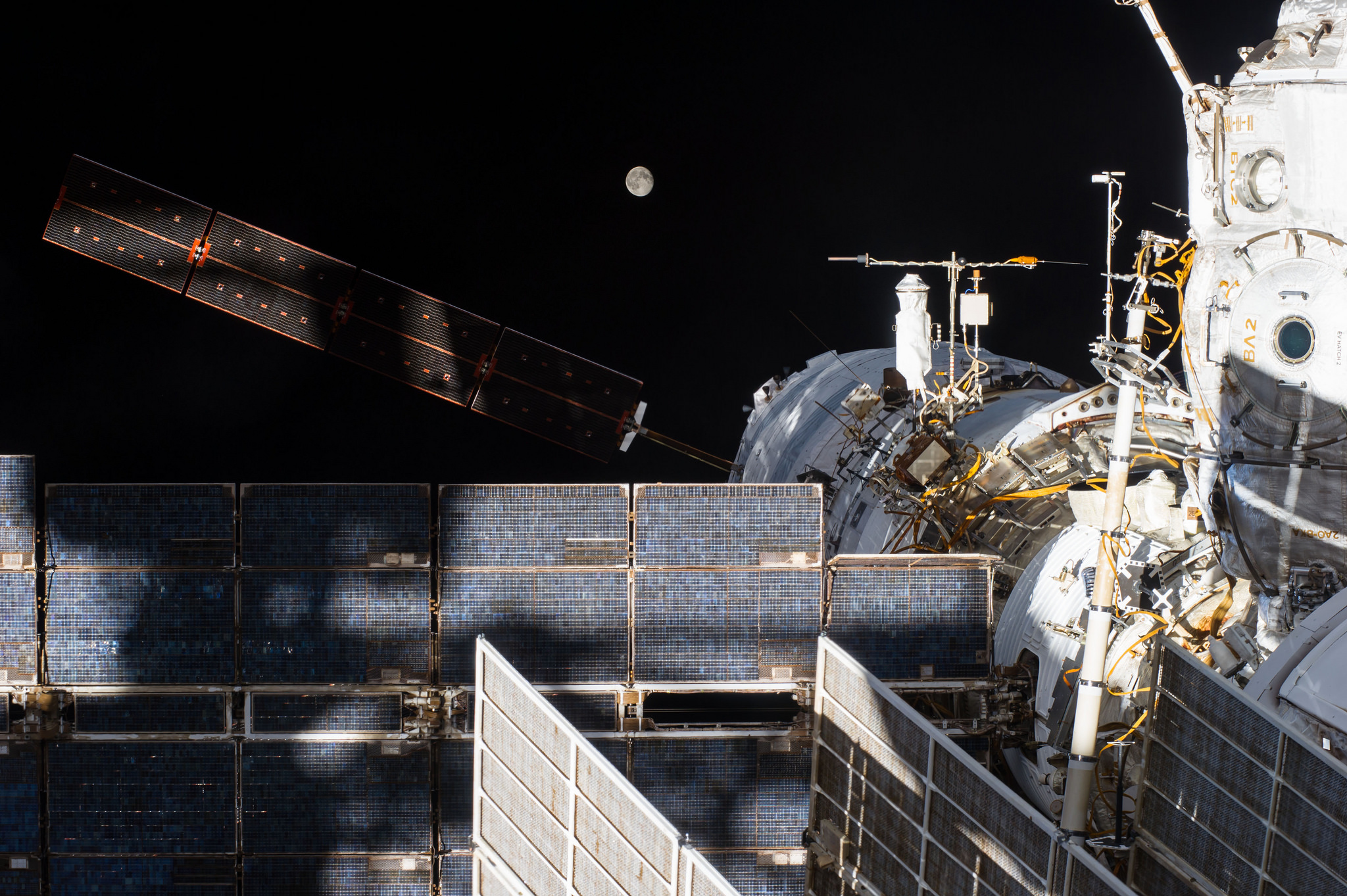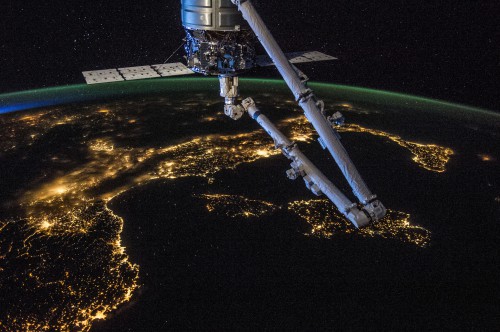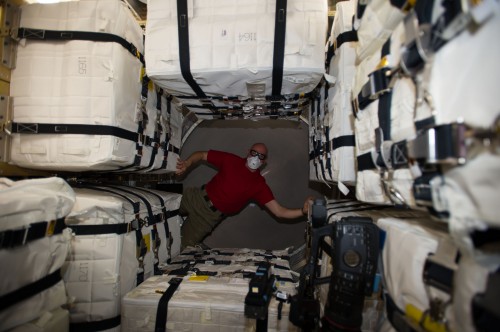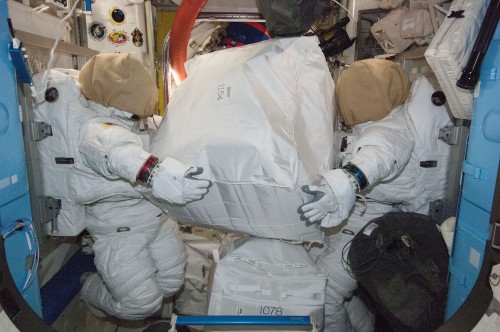
A hot and feverish summer of International Space Station (ISS) resupply operations is in high gear, following the successful deorbiting of Orbital Sciences Corp.’s second dedicated Cygnus cargo ship (ORB-2) on Sunday, 17 August, and preparations to resume unloading the European Space Agency’s (ESA) recently arrived fifth Automated Transfer Vehicle (ATV-5) on Tuesday, 19 August. In the meantime, waiting in the wings, SpaceX plans to deliver its fourth Dragon cargo mission (SpX-4) toward the multi-national outpost a week later than originally planned, on 19 September, carrying among its payload complement critical long-life batteries to support a pair of U.S. EVAs, later in the year. Dovetailed into this tightly orchestrated manifest are the undocking and departure of Soyuz TMA-12M on 10/11 September, temporarily reducing the ISS crew to three men, and the launch of Soyuz TMA-14M on the 25th with a new trio of spacefarers to boost the station back up to its nominal, six-person strength.
Currently occupied by U.S. astronaut Steve Swanson and Russian cosmonauts Aleksandr Skvortsov and Oleg Artemyev—all launched aboard Soyuz TMA-12M in March—together with Russian cosmonaut Maksim Surayev, U.S. astronaut Reid Wiseman, and Germany’s Alexander Gerst, who arrived aboard Soyuz TMA-13M in May, the ISS is presently in the final weeks of Expedition 40. On 11 September, Swanson, Skvortsov, and Artemyev will board their spacecraft and undock from the space-facing (or “zenith”) port of the station’s Poisk module and return to Earth. In readiness for their departure, Swanson will relinquish his command of Expedition 40 to Surayev, who will lead Expedition 41 until November. Swanson, Skvortsov, and Artemyev will complete about 169 days in orbit when their Soyuz descent module touches down in Kazakhstan.
After two weeks as a three-man team in orbit, Surayev, Wiseman, and Gerst will be joined on 25 September by the Soyuz TMA-14M crew of NASA astronaut Barry “Butch” Wilmore and cosmonauts Aleksandr Samokutyayev and Yelena Serova, the latter of whom will become Russia’s fourth woman to enter space and only its second to embark on a long-duration mission. Their docking at Poisk is expected about six hours after launch and their arrival will boost Expedition 41 to six-person capability. Under normal circumstances, the ISS Program operates this “indirect” handover of crews, whereby a given three-member subset departs the station, reducing the population to three, after which another three-member team is launched to restore it back to six. On only a handful of occasions—most recently in November 2013—“direct” handovers have been required for operational reasons, with the ISS crew temporarily increased to as many as nine members for a short period.

With both commercial companies (SpaceX and Orbital Sciences) and governmental space agencies (from Europe, Japan, and Russia) periodically restocking the ISS, the summer of 2014 has been one of its busiest periods to date. In mid-July, Orbital launched its ORB-2 Cygnus mission and berthed it successfully at the Earth-facing (or “nadir”) port of the station’s Harmony node for a month-long period of cargo transfers. During this period, the Expedition 40 crew unloaded about 3,290 pounds (1,490 kg) of cargo, including “care packages” from their families and friends, together with food, hardware, medical supplies, equipment, and tools. As planned, Cygnus was robotically released by Gerst and Wiseman, using the station’s 57.7-foot-long (17.6-meter) Canadarm2, at 8:42 a.m. EDT Friday, 15 August, heading for a fiery destruction in the upper atmosphere on Sunday.
The deorbit “burn” of Cygnus’ thrusters duly got underway early Sunday morning, by which point the cargo craft was about 340 miles (550 km) “behind” and about 15.5 miles (25 km) “below” the ISS. “This set-up has been chosen so that Cygnus will be directly below ISS when hitting Entry Interface, so that the destructive portion of the re-entry can be observed,” explained Spaceflight101. “The deorbit burn lowers the perigee of the orbit to dip deep into the atmosphere in order to start re-entry at a pre-determined location.” During the final phase of its mission, Cygnus experienced a rupturing and break-up of its pressurized hull and any fragments surviving re-entry were expected to plunge harmlessly into an uninhabited stretch of the Pacific Ocean. This marked the end of the second of eight dedicated Orbital Sciences Cygnus missions—including January’s ORB-1, which came on the heels of last September’s ORB-D demo flight—which the company is expected to conduct by 2016 under the language of a $1.9 billion Commercial Resupply Services (CRS) contract with NASA.
Also bound by the provisions of a similar CRS contract is SpaceX, which has launched three dedicated Dragon flights, in October 2012, March 2013, and most recently in April 2014. Like Orbital Sciences, SpaceX was also required to execute its own demo flight, which it completed in May 2012. More than two years later, its fourth dedicated mission (SpX-4) is reportedly postponed until no earlier than 19 September and is scheduled to launch atop a Falcon 9 v1.1 rocket from Space Launch Complex (SLC)-40 at Cape Canaveral Air Force Station, Fla. Two days after it departs Earth, the Dragon will be robotically captured by Wiseman and Gerst, again using Canadarm2, and berthed at the Harmony nadir port. It is expected to deliver a total of 5,000 pounds (2,272 kg) of payload to the ISS, including a General Laboratory Active Cryogenic ISS Experiment Refrigerator (GLACIER), the Commercial Generic Bioprocessing Apparatus (CGBA), the Microgravity Science Lab (MSL), and an experimental rodent housing facility. External payloads include the $26 million Rapid Scatterometer (RapidScat), for installation on Europe’s Columbus laboratory module. As the only ISS cargo ship capable of returning payloads to Earth, Dragon is expected to bring about 3,820 pounds (1,734 kg) back home in October, at the end of its month-long mission.

With Cygnus having recently departed the ISS, and Dragon shortly to arrive, another cargo ship providing a “bridge” between the two is ESA’s fifth and final Automated Transfer Vehicle (ATV-5), named in honor of the Belgian priest and astronomer Georges Lemaître. Launched from the Guiana Space Centre in Kourou, French Guiana, on 29 July, the vehicle followed an automated, two-week rendezvous profile to reach the space station. It docked successfully at the aft longitudinal port of the Zvezda service module at 3:30 p.m. Central European Time (9:30 a.m. EDT) Tuesday, 12 August, as the two spacecraft orbited high above Kazakhstan. As described by ESA, the lengthy rendezvous protocol included a “fly-under” of the ISS on 8 August, during which ATV-5 passed about 5 miles (8 km) “beneath” its quarry, in order to acquire video footage as part of the Laser Infrared Imaging Sensors (LIRIS) guidance system. “The technology is the first step towards a future system that would allow rendezvous with an uncooperative target in space,” it was noted. “On future missions, infrared cameras and the lidar sensors—the light equivalent of radar—would scan the targets, while on-board computers process the data using new guidance, navigation and control software.”
“To develop such an uncooperative system, new types of sensors, image processing and guidance, navigation and control systems and algorithms have to be developed and tested,” explained Spaceflight101, “covering the entire rendezvous phase from the long-range to the mid-range and into final approach to an on-target docking. Both units are installed on the forward facing portion of ATV to gather navigation data along with the operational rendezvous sensors, but LIRIS was only recording data and not feeding it to ATV’s computers for use in rendezvous navigation. The data recorders of LIRIS will be removed from ATV and returned to Earth aboard a Soyuz spacecraft.”
Following the 8 August fly-under maneuver, ATV-5 executed a further three maneuvers on Sunday, 10 August, to raise its altitude “above” the station, in order that the latter could overtake it in a lower, faster orbit. The cargo ship then performed a trio of “retrograde” maneuvers to re-establish itself back into its lower altitude in order to begin the final stages of the rendezvous. From a distance of 25 miles (40 km), ATV-5 guided its movements by means of relative satnav signals, in which both it and the ISS compared their relative positions with Global Positioning System (GPS) data. At 820 feet (250 meters), the cargo ship transitioned to a “videometer” and “telegoniometer,” in which laser pulses were transmitted at a rate of about 600 per minute and reflected via 26 reflectors on the Zvezda module to calculate the distance between the two vehicles.

Monitored closely from aboard the ISS by Expedition 40 crewmen Aleksandr Skvortsov and Alexander Gerst, these reflections generated a “light pattern” which was captured by instruments aboard ATV-5. “The spacecraft’s on-board computers then calculate the six-degree-of-freedom geometry between ATV and Zvezda,” Spaceflight101 explained. “As a backup system, two telegoniometers and rotating mirrors also used laser light to determine ATV’s position relative to the docking target.” At length, the cargo ship was authorized to enter the “Keep Out Sphere” (KOS), which extends about 660 feet (200 meters) around the ISS to prevent collisions. After a perfect automated docking, hooks and latches were closed to establish a firm mechanized embrace, and, later, electrical and data connections were established to permit ATV-5 to draw power and communicate with its giant host.
Loaded with more than 14,300 pounds (6,500 kg) of cargo for the Expedition 40 crew, the hatch between Zvezda and ATV-5 was opened on Wednesday, 13 August, after which Gerst and Skvortsov—clad in goggles and masks, to guard against any contaminants in the atmosphere—entered the cargo ship to begin an inspection of the state of its interior. They found nothing amiss, with all payloads still secured in their launch positions, and air sampling for carbon monoxide and other toxins produced nothing out of the ordinary. On Thursday, 14 August, piece by piece, they removed the 790-pound (360-kg) Electromagnetic Levitator (EML), a fundamental materials science payload destined for installation in the Columbus module. Swanson and Gerst temporarily installed it in the module’s European Drawer Rack. Also on Thursday, ATV-5 supported a test of its ability to “reboost” the ISS, firing its engines for just under eight minutes to change the station’s velocity by 3.6 feet per second (1.1 meters per second) and create the proper conditions for the departure of Soyuz TMA-12M on the evening of 10 September. Later this month, the cargo ship will perform its first major reboost of the station’s orbital altitude.
Operations to unload ATV-5 are expected to resume on Tuesday, 19 August, following tomorrow’s (Monday) planned six-hour EVA by cosmonauts Skvortsov and Oleg Artemyev. The two men—both making their second EVAs, having previously spacewalked together for almost 7.5 hours on 19 June—are tasked with a nanosatellite deployment, several air-sampling tasks, the removal and installation of several external experiments, and photography of multi-layered insulation on the station’s Russian Orbital Segment (ROS). Two other EVAs from the U.S. Orbital Segment (USOS), the first involving Swanson and Wiseman, the second Wiseman and Gerst, have been postponed, reportedly due to an issue with the usage and risk of the current long-life batteries aboard the Extravehicular Mobility Unit (EMU) space suits. A set of replacement batteries will form part of the cargo complement aboard the SpX-4 Dragon mission, possibly enabling Wiseman and Gerst to execute both EVAs as early as the end of September or the beginning of October. Following news of the delay, Gerst spent part of 8 August stowing EVA tools and equipment in the Quest Airlock.
With Cygnus gone, ATV-5 underway and SpX-4 upcoming, the pace of Visiting Vehicles to the ISS shows no sign of slackening in the final months of 2014. Assuming an on-time launch of the next Dragon, it will be unberthed and returned to Earth in the first half of October, with Orbital Sciences’ ORB-3 cargo mission presently scheduled to begin with a liftoff aboard an Antares booster from the Mid-Atlantic Regional Spaceport (MARS) on Wallops Island, Va., on 14 October. After berthing on the 17th, the new Cygnus will remain in place until 28 November, whereupon it will be deorbited and replaced a few days later by the SpX-5 Dragon, currently targeted for a 1 December liftoff. In tandem with these activities, Russia will launch its fourth and final Progress cargo ship of the year—Progress M-25M—from the Baikonur Cosmodrome in Kazakhstan in late October, which follows in the footsteps of February’s Progress M-22M, April’s Progress M-23M, and July’s Progress M-24M.
Want to keep up-to-date with all things space? Be sure to “Like” AmericaSpace on Facebook and follow us on Twitter: @AmericaSpace



